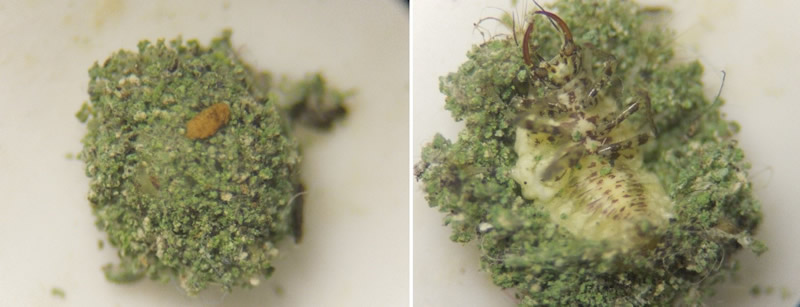Issue 8, July 29, 2020
Aphid Lions
Green lacewing larvae are out in force, eating aphids. These larvae are called aphid lions, but more like little alligators than lions. They have large, curved and hollow mandibles which they use to inject a paralyzing venom and extract the juices of the aphid. After feeding, they throw the carcass down on the ground. One aphid lion can eat 600 aphids in 14 to 20 days. They also go for other small bodied invertebrates such as caterpillasr, beetles, scales, mealy bugs, leaf hoppers, thrips, and mites.

Green lacewing larvae eating an aphid – Photo by Heather Lash
Aphid lion larva sometimes covers its body with carcasses of old aphids (past victims), debris, organic debris like lichens or vegetation to help sneak into an aphid colony protected by ants. It is an adaption to get past ants that actually farm and care for the aphids. Without the armor, ants would throw the green lacewing larvae from the plant. Ants eat the honeydew (frass or poop) aphids produce. Aphids produce such sugar frass because they are unable to break down the sucrose of plants and must excrete it. This is why plant leaves are sticky when there is an aphid infestation.

Aphd lion covered in lichens and aphid carcasses – Photos by Andrew Holsinger
In the industry, this insect has been used as a beneficial insect purposely released for mealy bug and leafhopper issues. It is easy to order these eggs off the internet and put them at the base of the plant that you suspect will be overcome by a high aphid population. However, if you inspect leaves that have high aphid populations, you will inevitably run into an aphid lion larvae, egg, or see the adults pollinating flowers.
Adults prefer to lay eggs where aphids or other prey can be found. They are white eggs that are laid singly on stalk to prevent cannibalism from the other larvae, or perhaps ants. Most gardeners have seen these eggs before and probably wondered what they were. The adult green lacewing is Small, pale green, delicately veined wings. You will see these all the time in the garden feeding on pollen and nectar and sometimes honeydew. They have a beautiful, golden iridescent type of eyes, green bodies, and most are active at night but can spy them flying around in the day.
Author:
Kelly Allsup